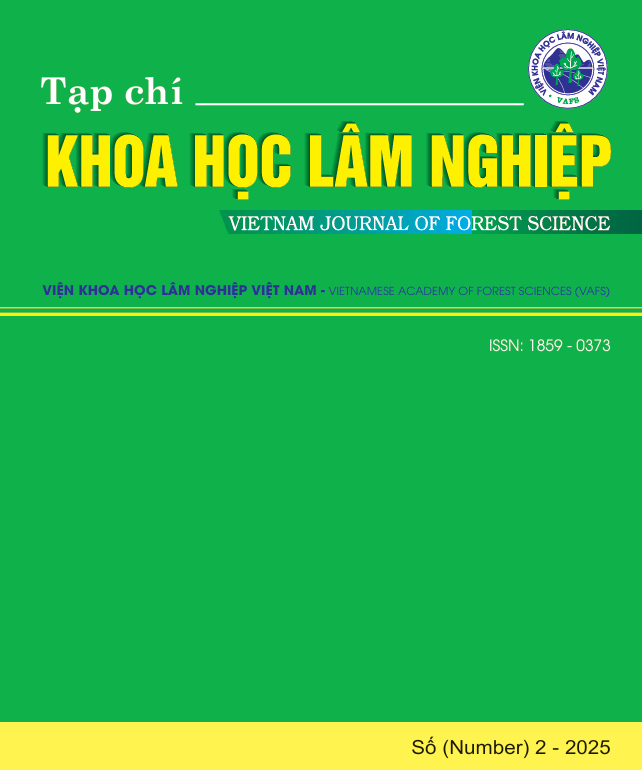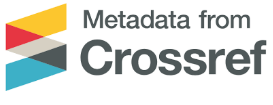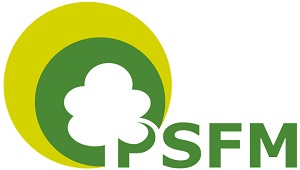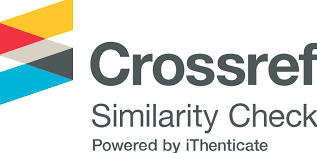ĐỀ XUẤT BẢN ĐỒ VÙNG PHÙ HỢP TRỒNG CÀ PHÊ TẬP TRUNG CHO SẢN XUẤT NÔNG, LÂM NGHIỆP HUYỆN MAI SƠN, TỈNH SƠN LA
DOI:
https://doi.org/10.70169/VJFS.1046Từ khóa:
AHP, cây cà phê, GIS, huyện Mai Sơn - Sơn La, vùng phù hợpTóm tắt
Sơn La là tỉnh miền núi vùng Tây Bắc Việt Nam, có diện tích trồng cà phê lớn nhất trong vùng. Để đáp ứng nhu cầu hội nhập quốc tế, tỉnh Sơn La đã có nhiều chính sách khuyến khích, đầu tư phát triển vào cây cà phê trên địa bàn tỉnh với mong muốn đưa thương hiệu Cà phê Sơn La trở nên phổ biến hơn trên thị trường thế giới. Tuy nhiên, hiện nay diện tích trồng cà phê ở Sơn La chỉ ở quy mô hộ gia đình, bị phân tán. Do đó, nghiên cứu này nhằm xác định vùng phù hợp trồng cây cà phê tập trung theo tiếp cận kinh tế - xã hội - môi trường tại các xã nghiên cứu điểm. Đề xuất vùng phù hợp trồng cà phê tập trung đã xác định được 2.089,6 ha phù hợp cao, 10.521 ha phù hợp trung bình tại khu vực huyện Mai Sơn - Sơn La và nằm trong quy hoạch sử dụng đất nông, lâm nghiệp của địa phương.
Tài liệu tham khảo
1. Bianchini, S., Solari, L., Del Soldato, M., Raspini, F., Montalti, R., Ciampalini, A., & Casagli, N., 2019. Ground Subsidence Susceptibility (GSS) Mapping in Grosseto Plain (Tuscany, Italy) Based on Satellite InSAR Data Using Frequency Ratio and Fuzzy Logic. Remote Sensing, 11(17), 2015. https://doi.org/10.3390/rs11172015
2. Bộ Nông nghiệp và phát triển Nông Thôn, 2010. TCVN 8409:2010 về đánh giá đất nông nghiệp. https://luatminhkhue.vn/tieu-chuan-quoc-gia-tcvn-8409-2010-ve-quy-trinh-danh-gia-dat-san-xuat-nong-nghiep-phuc-vu-quy-hoach-su-dung-dat-cap-huyen.aspx
3. Bộ Nông nghiệp và phát triển Nông Thôn, 2024. Quyết định 431/QĐ-BNN-TT. https://thuvienphapluat.vn/van-ban/Linh-vuc-khac/Quyet-dinh-431-QD-BNN-TT-2024-De-an-phat-trien-cay-cong-nghiep-chu-luc-den-2030-602966.aspx
4. Caner, H. I., & Aydin, C. C., 2021. Shipyard site selection by raster calculation method and AHP in GIS environment, İskenderun, Turkey. Marine Policy, 127, 104439. https://doi.org/10.1016/j.marpol.2021.104439
5. Canh P. X., 2018. Đánh giá điều kiện tự nhiên phát triển cây cao su huyện Mường La, tỉnh Sơn La. VNU Journal of Science: Earth and Environmental Sciences, 34(2). https://doi.org/10.25073/2588-1094/vnuees.4256
6. Carrubba, A., Militello, M., & Catalano, C., 2013. Maps in Scily: Cultivation, Uses and Potentiality. Acta Horticulturae, 997, 277–282. https://doi.org/10.17660/ActaHortic.2013.997.34
7. Cienciała, A., Sobura, S., & Sobolewska-Mikulska, K., 2022. Optimising Land Consolidation by Implementing UAV Technology. Sustainability, 14(8), 4412. https://doi.org/10.3390/su14084412
8. Feizizadeh, B., Jankowski, P., & Blaschke, T., 2014. A GIS based spatially-explicit sensitivity and uncertainty analysis approach for multi-criteria decision analysis. Computers & Geosciences, 64, 81–95. https://doi.org/10.1016/j.cageo.2013.11.009
9. Food and Agriculture Organization of the United Nations., 1976. A Frameworkmfor land evaluation. (Soil Bulletin 32).
10. Jeganathan, C. (n.d.).,2003. Development of Fuzzy Logic Architec- ture to assess the sustainability of the Forest Management.
11. Li, Z., 2021. An enhanced dual IDW method for high-quality geospatial interpolation. 11(9903).
12. Liu, Y.-S., Wang, J.-Y., & Guo, L.-Y., 2006. GIS-Based Assessment of Land Suitability for Optimal Allocation in the Qinling Mountains, China. Pedosphere, 16(5), 579–586. https://doi.org/10.1016/S1002-0160(06)60091-X
13. Özkan, B., Dengiz, O., & Turan, İ. D., 2020. Site suitability analysis for potential agricultural land with spatial fuzzy multi-criteria decision analysis in regional scale under semi-arid terrestrial ecosystem. Scientific Reports, 10(1), 22074. https://doi.org/10.1038/s41598-020-79105-4
14. Palchaudhuri, M., & Biswas, S., 2016. Application of AHP with GIS in drought risk assessment for Puruliya district, India. Natural Hazards, 84(3), 1905–1920. https://doi.org/10.1007/s11069-016-2526-3
15. Popovic, G., Stanujkic, D., Brzakovic, M., & Karabasevic, D., 2019. A multiple-criteria decision-making model for the selection of a hotel location. Land Use Policy, 84, 49–58. https://doi.org/10.1016/j.landusepol.2019.03.001
16. Saaty, T. L., 1984. The Analytic Hierarchy Process: Decision Making in Complex Environments. In R. Avenhaus & R. K. Huber (Eds.), Quantitative Assessment in Arms Control (pp. 285–308). Springer US. https://doi.org/10.1007/978-1-4613-2805-6_12
17. Saaty, T. L., 2008. Decision making with the analytic hierarchy process. International Journal of Services Sciences, 1(1), 83. https://doi.org/10.1504/IJSSCI.2008.017590
18. Shrestha, R. R., Acharya, A., Karmacharya, N., Sapkota, M., Paudyal, B., Basnet, P., Timilsina, S., & Shakya, H. D., 2022. Application of AHP and GIS for Optimal Solar site Indentification in Madhesh Province, Nepal. International Journal of the Analytic Hierarchy Process, 14(3). https://doi.org/10.13033/ijahp.v14i3.986
19. Thông Tư 01/2021/TT-BXD QCVN 01:2021/BXD Quy chuẩn kỹ thuật quốc gia về quy hoạch xây dựng mới nhất (2024). https://thuvienphapluat.vn/van-ban/Xay-dung-Do-thi/Thong-tu-01-2021-TT-BXD-QCVN-01-2021-BXD-Quy-chuan-ky-thuat-quoc-gia-ve-Quy-hoach-xay-dung-474747.aspx
20. Ủy ban nhân dân tỉnh Sơn La, 2021. Quy hoạch sử dụng đất tỉnh Sơn La, Sơn La.
21. Vafaie, F., Hadipour, A., & Hadipour, V., 2015. GIS-Based Fuzzy Multi-Criteria Decision Making Model for Coastal Aquaculture site Selection Environmental Engineering and Management Journal, 14(10), 2415–2425. https://doi.org/10.30638/eemj.2015.258
22. Yamane, T., 1967. Statistics: An introductory analysis (2nd ed.). New York: Harper and Row.
23. Zandebasiri, M., & Pourhashemi, M., 2016. The Place of AHP Method among the Multi-criteria Decision Making Methods in Forest Management. 6(2).
24. Zarandi, S. M., Shahsavani, A., Nasiri, R., & Pradhan, B., 2021. A hybrid model of environmental impact assessment of PM2.5 concentration using multi-criteria decision-making (MCDM) and geographical information system (GIS)-A case study. Arabian Journal of Geosciences, 14(3), 177. https://doi.org/10.1007/s12517-021-06474-z













